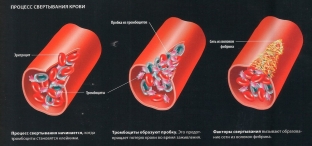The loss of a large amount of blood in a person can be fatal, which is why the body has a hemostasis system, the task of which is to prevent this problem. Failures in the operation of this system are manifested by a violation of blood clotting. This pathology is deadly, therefore it is important to detect its signs in a timely manner and consult a hematologist for adequate treatment. Therefore, today estet-portal.com will consider the main causes and symptoms of improper blood clotting.
Causes of bleeding disorders
During the normal functioning of the hemostasis system, in the event of damage to the blood vessels, a complex process is triggered, during which the blood begins to clot in order to avoid significant loss of it. If blood clotting is impaired, the most common cause of the problem is an insufficient amount or absence of blood clotting factors, which is characteristic of a number of diseases and the use of certain drugs:
- hemophilia (more about the disease at http://hemokids.org.ua/);
- vitamin K deficiency;
- liver dysfunction;
- DIC syndrome;
- pernicious anemia;
- tumor diseases;
- side effects of anticoagulants and cytostatics;
- Willebrand disease;
- Wergolf's disease;
- Glantzman's thrombasthenia;
- Afibrinogenemia and dysfibrinogenemia.
Causes of blood clotting disorders can be either genetic or acquired.
Thus, the causes of disorders of the blood coagulation process can be both genetic and acquired. In any case, it is important to know about:
- symptoms;
- diagnostics;
- treatment for bleeding disorders.
How do bleeding disorders manifest themselves?
A patient may suspect a bleeding disorder if he does not stop bleeding for a long time. However, there are other characteristic symptoms, noticing which, it is necessary to consult a hematologist, since they may also indicate a malfunction of the hemostasis system. These include:
- bruising for no apparent reason;
- heavy menstrual bleeding;
- frequent nosebleeds;
- inability to stop bleeding with minor wounds;
- bleeding gums;
- redness of the whites of the eyes;
- bleeding into the skin;
- black feces (for hemorrhages in the gastrointestinal tract).
Remember that the symptoms described above should never be left unattended by a doctor. If you are unable to stop the bleeding from the wound, be sure to call an ambulance.

Diagnostics for bleeding disorders
The diagnostic measures that are given to determine blood clotting include taking an anamnesis, as well as conducting tests.
Thus, the doctor may ask the patient about the presence of any concomitant symptoms, the frequency and nature of bleeding, the duration of bleeding, medications taken, previous and current illnesses, and cases of blood clotting disorders in the family.
Tests performed:
- complete blood count;
- platelet aggregation analysis;
- bleed time measurement.
If a bleeding disorder is confirmed, it is necessary to identify the cause of the pathology in order to prescribe adequate treatment.
Timely therapy will minimize the risk of life-threatening complications of poor blood clotting, which include:
- cerebral hemorrhage;
- bleeding in the gastrointestinal tract;
- bleeding in the joints.
Each patient should understand that disturbances in the hemostasis system – an extremely dangerous pathology in which self-treatment with folk remedies is completely excluded.
What is the treatment for bleeding disorders?
Each patient should understand that disturbances in the hemostasis system – an extremely dangerous pathology in which self-medication with folk remedies is completely excluded. To prescribe effective therapy, as indicated above, it is necessary to determine the source of the problem, since each disease, accompanied by a violation of blood clotting, has its own characteristics of treatment.
Additional Therapies:
- vitamin K injections;
- drugs to improve clotting;
- blood transfusion;
- drugs to treat platelet-related disorders.
If a patient sees a doctor after losing a significant amount of blood, the doctor may prescribe iron supplements, since iron deficiency is fraught with anemia. In this case, a blood transfusion may also be needed.
Estet-portal.com reminds that blood clotting disorder – life-threatening pathology, which, without the timely intervention of a qualified doctor, can be fatal. Therefore, in no case do not ignore the symptoms of this disorder and in no case resort to self-medication.






Add a comment